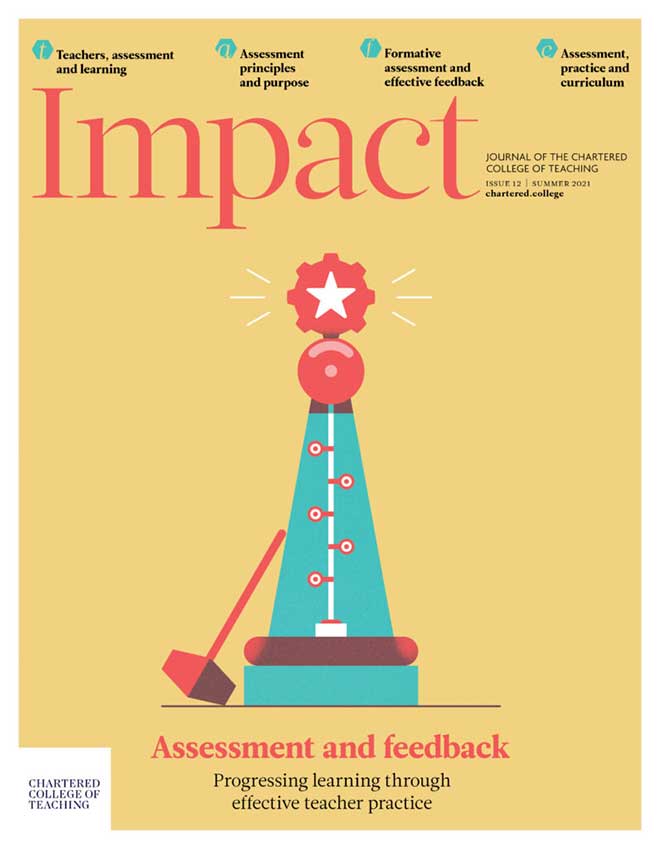FROM THE EDITOR
Chris Harrison, Professor of Science Education, King’s College London, UK
Increasingly, over the last couple of decades, assessment practices in schools have been of great interest to the public and often criticised within the media. This negative approach to assessment has been especially apparent over the last year, as the COVID-19 pandemic has resulted in periods of schooling at home for all youngsters, with those who are vulnerable due to health conditions learning from home for the whole year. As learners return to school after lockdown, the mantra is around ‘catch-up’ and ‘learning loss’, the highlighting of inequalities within our education systems and concerns around the awarding of qualifications in the summer. While assessment clearly has a role to play in all of these things, what is important to consider is what might be a more fruitful approach to assessment and reconceptualising what we mean by assessment in education.
The current educational literature is full of different positions and terminology with regard to assessment, which teachers, students and other stakeholders can find confusing. What needs to be focused on, at this time, is the role that assessment plays in informing current understanding of how students learn and how their knowledge and conceptual understanding grow. Foster (2009) refers to this as informative assessment, which centres on how teachers and students make use of assessment information to understand and improve learning. She refers to informative assessment as bringing together ‘research underpinning “assessment for learning” with research on high performing school systems; how students learn and highly effective teachers’ (p. 5). This distinction seems apt for this editorial, since the many excellent papers both within this issue and online traverse these domains, while offering useful ways forward for teaching and learning, once appropriate evidence has been selected and analysed through assessment. At the same time, we need to ensure confidence in assessments by checking that they are sufficiently valid and reliable so that we know what is actually being assessed and how clear we are about what the evidence infers about our learners and learning. These ideas run through most of the articles in this issue, bringing together key aspects from assessment theory and practice.
Assessment for learning
The assessment approaches that we select or design, the kinds of tasks that we assign and the ways in which we communicate success or failure, both within the classroom and with other stakeholders, communicate powerful messages to students, not only about their own learning but also about the nature of learning itself. Assessment and reporting practices can shape beliefs about learning – sometimes in unintended ways.
The importance of understanding assessment principles and embedding assessment practices in day-to-day teaching is recognised in both the ‘Early Career Framework’ (Department for Education, 2019) and the ‘Professional standards for teaching and leadership’ (Welsh Government, 2017). These frameworks call for the development of teacher assessment literacy, which relates to the teacher’s capability of interrogating and using assessment appropriately (Stiggins, 1991). Such practice requires an understanding of how different purposes for assessment connect to make decisions about classroom activities and how evidence collected within the assessment process feeds back into teaching and learning. Simon Childs and Sally Brown write about this and also consider both the challenges and insights that have arisen in response to the COVID-19 pandemic, affecting the way in which national qualifications are assessed. While initially there was great concern over recent changes in how grades are decided at the end of GCSE, GCE and other qualifications, many see opportunity in the profession for rethinking and re-establishing teacher assessment practices within high-stakes assessment jurisdictions.
Research studies highlight the fact that learners learn best when they understand what they are trying to learn and what is expected of them, and when they are given regular feedback about the quality of their work and what they can do to improve (Black et al., 2004). ‘Assessment and classroom learning’ (Black and Wiliam, 1998a) provides a sophisticated analysis of the literature related to formative assessment, evidencing its value and emphasising the role of feedback and of active student participation in learning. These ideas were condensed into a booklet for teachers, Inside the Black Box (Black and Wiliam, 1998b), setting out a range of reasons why and suggestions for how teachers might enact formative assessment in the classroom, and emphasising that every teacher needs to develop their own ways of embedding these ideas in their classroom practices. The booklet also recommends that teachers need access to a variety of examples from other teachers, with whom they can identify and from whom they can derive conviction and confidence, which they can enhance and use to make changes to their current pedagogy. What is key here is for teachers to focus on what happens in the classroom as teachers and learners interact and get feedback from one another, and how they might use this evidence and related decisions for determining next steps on the learning pathway.
For all those with a direct interest in what happens at classroom level, assessment needs to be about evidence of progress in the growth of learning. It is this information that is required to drive feedback and formative action, providing both drive and motivation as well as the means for supporting improvement and growth. Unfortunately, many debates among educators focus on the mode of assessment rather than on consistency or usefulness of evidence in this process. There is also a tendency for some teachers and schools to consider assessment evidence in isolation, viewing it as a single measure rather than considering it as part of the evidence leading up to that point in the learning. A holistic approach to considering assessment evidence provides a more coherent picture of individual and group learning. In this way, different sources of evidence about student growth converge, resulting in a more analytical and informative use of that evidence within teaching and learning. This leads to better understanding of how learning was achieved and which processes can be drawn on in consequent learning episodes, ensuring that the actions of teachers and learners are proactive and responsive (Harrison, 2015). Julian Grenier refers to this in Early Years settings in this issue when he claims that ‘we should use assessment to improve children’s learning; it should serve our work, not drive it’ (p. 26).
Helen Angell’s article focuses on the importance of collaboration among teachers in the assessment process, since it is when teachers have quality conversations, where they look for evidence and agree judgements together, that they gain more confidence in their decisions. Such professional interactions allow teachers to share disciplinary expertise and nurture the guild knowledge (Sadler, 1989) that they build as they reach agreements and justify their thinking to others. Strengthening teachers’ assessment literacy through professional collaboration is therefore an important stepping stone towards better teacher assessment practices; this is also acknowledged in Sarah Earle, Tom John, and Antonio Griffiths-Murru and Christine Parker’s pieces, where they look at ideas in assessment theory that are pertinent to good practice.
Ryan Campbell and Christian Bokhove consider the literature associated with rubrics and introduce some of the themes within the recent Pandero and Jonsson (2020) review. Their article outlines the arguments for and against using rubrics, focusing mainly on whether rubrics are sufficiently comprehensive to capture notions of quality and whether they can be effective in informing next steps. They argue that criticisms against rubrics have been overstated and that rubrics remain a useful tool as long as users are aware of some limitations, such as students being incentivised to narrowly reproduce the rubric features in their work. Their article includes a range of ways in which teachers have utilised rubrics in their teaching to fashion a more formative approach.
Learner and teacher roles in assessment
Through a growth approach to assessment, learners take a more active role within assessment, fostering greater attention to and ownership of feedback, since it is their response to teacher or peer guidance that will help them to improve. Underpinning this assessment approach is a belief that every learner is capable of improvement (Dweck, 2006) if they can be engaged, supported and provided with opportunities to learn. Rather than expecting all students of the same age to reach the same point in their learning, this approach is ipsative, expecting every student to progress over time, regardless of their starting point (Masters, 2013).
This assessment mindset focuses on improvement, and this development needs to be factored into all the activities that teachers design and select for their learners, because it encourages the building of self-regulation skills. It then depends on how feedback is woven into the learning process and how evidence is used to inform classroom activities to enable those opportunities for improvement to occur. Such practices do put demands on learners, as they need to develop better assessment and feedback literacy to function effectively within this type of system. It also has high demands for teachers in forging new ways of working, particularly when, as reported by Mick Walker, there has been a lack of focus on assessment theory and practice in teacher preparation and professional development courses.
The consequences of defining educational assessment with reference to growth requires renegotiating the processes and interconnectedness of curriculum, teaching and assessment. If curriculum requirements are not organised with respect to developmental outcomes that clarify expected learning pathways, then recognising and communicating progress becomes an issue. This requires teachers and departments to consider the curriculum in terms of progression, understanding how and why learning outcomes build on one another. Decisions about next steps that arise from a progression perspective result in periods where some students might consolidate new learning while others attempt challenges to build more complex ideas. Differentiation therefore becomes a natural part of assessment and learning, with support tailored for individuals as and when necessary. Assessments of progress are therefore an alternative route to judging success only in terms of age-expected standards.
This move to teachers and schools defining, assessing and reporting learning in terms of the progress that individuals make is no small change. One of the burdening challenges to a growth approach to assessment arises from the widely held perception that the fundamental purpose of assessment in education is to judge how well students have learnt what they have been taught. Much of the field of assessment, including many assessment concepts and much of the language of assessment, was developed from this perspective. This theme is picked up in this issue by Chris Larvin, when he claims that accountability turns assessment purposes away from a learning perspective. It is therefore worth teachers re-evaluating the ways in which they articulate assessment ideas and provide feedback to learners. Some of this is alluded to in the various papers in this issue, and it is essential that, as teachers move forward with their assessment practices, they rebrand assessment from within a growth perspective. Although seemingly simple, this reconceptualisation represents a paradigm shift and has significant implications for practice. Most assessment practice is intimately linked to the current model of educational delivery, and any change in assessment practice is likely to impact on all aspects of teaching and learning.
Feedback and formative assessment
Feedback can have a huge impact on learning and attainment (Kluger and DeNisi, 1996; Black and Wiliam, 1998b; Hattie and Timperley, 2007), but feedback intervention studies also demonstrate a very wide range of effects. Feedback occurs through a variety of routes in the classroom, from noticing and responding to answers and points raised in discussion, to teachers supporting peer- and self-assessment activities, to providing comments on pieces of student work (Harrison, 2015). Feedback is therefore a complex and multiple set of actions that have many hits throughout lessons. Some of these feedback situations are easier to manage than others, such as when teachers discuss the quality of an essay with individuals. Other situations are less easy to control, as students witness other learners receiving praise or realise that they have misunderstood a practice exam question when peer-assessing one another’s work. Such scenarios are emotional, and while it would be difficult to overcome all such events, feedback tends to work better if it is focused on the task rather than the individual and on improvement rather than correction. Megan Price writes about how introducing more in-lesson diagnostic work supports a more formative approach, through providing instant feedback via live marking. A similar approach is taken by Victoria Foster and colleagues, who recognise the use of hinge-point questions in identifying misconceptions early in a topic and thus allowing time for challenge and the forming of new ideas.
Sadler (1989) highlighted the ‘indispensible’ role of active student participation in the assessment process and action on feedback, and a key factor in enabling formative feedback to work is that students fully engage with the guidance that they receive. Michael Chiles’ article focuses on the receptive culture that is needed for learners to be able to respond to feedback effectively and to also enable them to be more self-regulatory in their learning. Investment in feedback is also picked up in Simon Baron’s four case studies from modern foreign language classrooms, where he explores and unpacks students’ conceptions and feelings related to assessment opportunities in their lessons. He explores the use of metacognitive strategies used to plan, monitor and evaluate learning and recommends that empathetic assessment conversations are useful for students, both in making progress and in taking ownership of learning. Tracey Feil also highlights the need to collect learners’ views of feedback in order for teachers to understand what learners found useful at the time of assessment and feedback.
How teachers view assessment goes hand in hand with the pedagogical approach that they adopt in line with their view about how students learn. Assessing for progress necessitates teachers taking a more responsive approach to learning and incorporating both student ideas and opportunities for learners to develop self-regulatory processes. This process requires various levels of diagnostic detail to identify starting points for action and to monitor learning progress over time. To engage in this approach, teachers need to make changes to allow these new ways of working to filter into classroom practices and routines and to gradually merge into their everyday teaching repertoire (Heritage and Harrison, 2020). It is only then that assessment will serve as a means of supporting learning.
References
Black P, Harrison C, Lee C et al. (2004) Assessment for Learning: Putting it into Practice. London: OUP.
Black P and Wiliam D (1998a) Assessment and classroom learning. Assessment in Education: Principles Policy and Practice 5: 7–73.
Black P and Wiliam D (1998b) Inside the Black Box: Raising Standards Through Classroom Assessment. London: GL Assessment.
Department for Education (DfE) (2019) Early Career Framework. Available at: https://assets.publishing.service.gov.uk/government/uploads/system/uploads/attachment_data/file/913646/Early-Career_Framework.pdf (accessed 15 April 2021).
Dweck CS (2006) Mindset: The New Psychology Of Success. New York: Balantine Books.
Foster M (2009) Informative assessment: Understanding and guiding learning. Available at: https://research.acer.edu.au/cgi/viewcontent.cgi?article=1040&context=research_conference (accessed 15 April 2021).
Harrison C (2015) Assessment for learning in science classrooms. Journal of Research in STEM Education 1(2): 78–86.
Hattie J and Timperley H (2007) The power of feedback. Review of Educational Research 77(1): 81–112.
Heritage M and Harrison C (2020) The Power of Assessment for Learning: Twenty Years of Research and Practice in UK and US Classrooms. London: Sage.
Kluger AN and DeNisi A (1996) The effects of feedback interventions on performance: A historical review, a meta-analysis, and a preliminary feedback intervention theory. Psychological Bulletin 119(2): 254–284.
Masters GN (2013) Reforming Educational Assessment: Imperatives, Principles and Challenges. Australian Education Review 57. Melbourne: Australian Council for Educational Research.
Panadero E and Jonsson A (2020) A critical review of the arguments against the use of rubrics. Educational Research Review 30: 100329.
Sadler DR (1989) Formative assessment and the design of instructional systems. Instructional Science 18: 119–144.
Stiggins R (1991) Assessment literacy. Phi Delta Kappan 72: 534–539.
Welsh Government (2017) Professional standards for teaching and leadership. Available at: https://hwb.gov.wales/api/storage/19bc948b-8a3f-41e0-944a-7bf2cadf7d18/professional-standards-for-teaching-and-leadership-interactive-pdf-for-pc.pdf (accessed 15 April 2021).








































